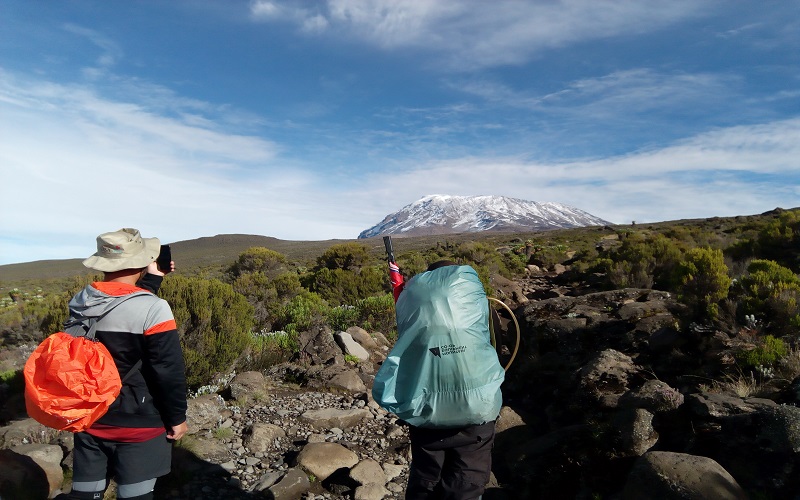Why Climb Kilimanjaro in Tanzania?
Mount Kilimanjaro, located in Tanzania, is the tallest freestanding mountain in the world and Africa’s highest peak. Trekking it doesn’t require technical climbing skills, making it one of the most accessible high-altitude climbs in the world. You’ll encounter stunning landscapes, rich cultural experiences, and the personal achievement of a lifetime.
Kilimanjaro Climbing Routes
- Marangu Route: Easiest with hut accommodations, 5–6 days.
- Machame Route: Challenging and scenic, 6–7 days.
- Lemosho Route: Quiet, very scenic, high success rate, 7–8 days.
- Rongai Route: Dry, northern approach, 6–7 days.
- Northern Circuit: Longest route, excellent acclimatization, 9+ days.
- Umbwe Route: Steep and fast, most difficult route.
- Shira Route: High-altitude start, joins Lemosho after Day 1.
Best Time for Kilimanjaro Climbing Tours
The best times to climb are from January to March and June to October. Avoid the rainy months of April, May, and November.
What’s Included in a Kilimanjaro Climbing Tour?
- Airport transfers & hotel stays
- All park fees and permits
- Certified guides, porters, and cooks
- Tents and sleeping pads
- Daily meals and water
- Health checks and emergency oxygen
- Rescue coordination
What to Expect on the Mountain
Climbers can expect to hike 4–8 hours daily in varied conditions — from warm rainforest to sub-zero summit nights. Accommodations are tents or huts depending on the route, and you’ll be eating simple but nourishing meals prepared by your crew.
What to Pack for Kilimanjaro
- Layered clothing system (base, insulation, waterproof)
- Good hiking boots (well broken-in)
- Sleeping bag (rated to at least -10°C)
- Headlamp, gloves, sunglasses
- Daypack (25–35L)
- Water bottles or hydration bladder
- Personal medications and toiletries
Safety on Kilimanjaro
The most common risk is altitude sickness. Reputable operators monitor your health with daily checks, provide oxygen and emergency evacuation, and design itineraries that support gradual acclimatization. Always travel with insurance that covers trekking up to 6,000m and emergency evacuation.
Kilimanjaro Climb Cost
Prices vary by route, duration, and comfort level:
- Budget: $1,500 – $2,000
- Mid-range: $2,000 – $3,000
- Luxury: $3,500+
Always ensure your tour includes safety gear, fair porter wages, and park fees.
Why Book With a Local Tanzanian Operator?
Choosing a Tanzanian-based operator supports local jobs, ensures authentic service, and often gives you better value than using an overseas agent. Look for companies registered with KPAP (Kilimanjaro Porters Assistance Project).
FAQs – Kilimanjaro Climbing Tours
1. Do I need to be very fit to climb Kilimanjaro?
No, but a good level of physical and mental endurance helps. Regular walking and cardio training are ideal.
2. How long does a Kilimanjaro climb take?
Anywhere from 5 to 9 days depending on the route and pace.
3. What is the best route for beginners?
Lemosho, Machame, or Northern Circuit due to better acclimatization and scenery.
4. When is the best time to climb Kilimanjaro?
January–March or June–October for best weather conditions.
5. What are the dangers or risks?
Altitude sickness, dehydration, and cold. Safety comes with choosing a good operator and acclimatizing properly.
6. Do I need travel insurance?
Yes — it must cover trekking up to 6,000m, evacuation, and trip delays.
7. Can children or older adults climb Kilimanjaro?
Yes, children above 10 and fit older adults can climb with proper support and pacing.
8. Will I have access to toilets and showers?
Most routes use public or portable toilets. Showers are rare — expect basic hygiene.
9. Is a guide mandatory?
Yes. All climbers must be accompanied by a licensed Tanzanian guide.
10. Can I rent gear in Tanzania?
Yes. Most operators provide gear rental for boots, jackets, sleeping bags, and more.
Yes. Most operators provide gear rental for boots, jackets, sleeping bags, and more.
conclusion
Climbing Mount Kilimanjaro is an awe-inspiring adventure that attracts trekkers from all over the world. Whether you're seeking a challenging trek or a memorable journey through diverse ecosystems and stunning views, Kilimanjaro offers an experience like no other. With the right preparation, support, and knowledge, you can conquer Africa's highest peak and achieve something extraordinary. Remember to choose the right route based on your fitness level, understand the risks of altitude sickness, pack accordingly, and ensure your safety by hiring professional guides. With proper planning, your Kilimanjaro climb can be an unforgettable and life-changing experience. We hope the information shared in this guide helps you plan your climb, from selecting the perfect route to understanding the essential safety precautions. If you're ready to embark on this once-in-a-lifetime journey, don't hesitate to reach out to a trusted tour operator for more details and to book your trip!
